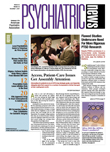“The only thing we have to fear is fear itself,” President Franklin Roosevelt declared.
Yet it's unlikely that many youngsters would agree with him, suggests a new study conducted by Australian and American researchers and published in the October Behavior Research and Therapy. They have found that youngsters' nighttime fears have an astonishing number of causes.
The investigators studied the sources of nighttime fears in a large, school-based sample of children and adolescents in Australia—511 youth aged 8 to 16 from various socioeconomic backgrounds. The youngsters indicated that they had experienced nighttime fears due to 34 different causes. The most common causes were, in order, noises inside or outside the house, an imagined intruder, scary dreams, darkness, imaginary creatures, the security of family or friends, animals, and worry about the day's events.
The senior investigator, Thomas Ollendick, Ph.D., director of the Child Study Center at Virginia Tech, told Psychiatric News that he wasn't surprised by these findings because a Dutch study of 176 children aged 4 to 12 produced similar results. But a result from the Australian study that did surprise him, Ollendick said, was the large percentage of youngsters—64 percent—who experienced nighttime fears either frequently or occasionally. “We anticipated that it would be more around a third,” Ollendick said.
The study also revealed that significantly more children than adolescents, and more females than males, experienced nighttime fears often or occasionally.
The study likewise showed that whereas children were more prone to certain types of fears than adolescents were, adolescents were also more prone to certain types of fears than children were. Still other types of fears were equally prevalent in both groups.
For example, children were more likely to be afraid of scary dreams or fantasy creatures, while adolescents were more likely to be disturbed by troubling thoughts. Yet other sources of angst—noises inside or outside the house, darkness, and the security of family and friends—were equally prevalent among both children and adolescents.
The youngsters in the study were asked what strategies they used to cope with their nighttime fears. Their two most common strategies were trying to ignore their worries and thinking about something else or going to their parents and talking to them about their worries. Strategies they used less often included turning on a light, clinging to a stuffed animal, asking their parents for a drink, or praying.
Finally, the parents of the youngsters who participated in the study were asked how often they thought their offspring had nighttime fears. They dramatically underestimated what the youngsters themselves reported.
The study results have “tremendous implications” for child and adolescent psychiatrists, Ollendick believes. For example, although the youngsters who participated in the study came from the community, not from a clinical sample, nighttime fears in about 10 percent were related to one or more anxiety disorders as defined by DSM criteria. Separation anxiety was the most common.
“Child and adolescent psychiatrists need to be aware that nighttime fears may be frequent, severe, and of long duration for some children,” Jocelynne Gordon, Ph.D., of Monash University in Victoria, Australia, and lead study investigator, added. “A DSM-based assessment for specific phobia and other anxiety disorders may be indicated. Medical assessments for child sleep disturbances also need to include questions about the child's anxiety and fear experienced at night.”
Gordon, Ollendick, and their group will now be looking at nighttime fears across different cultures and will attempt to determine whether co-sleeping protects against such fears or leads to more of them. Co-sleeping is commonly understood as a child sleeping with his or her parents for an extended period of time, sometimes until ages 5, 7, or even 9.
Although it is generally frowned upon in the United States, it is common in countries such as China, Italy, Japan, Spain, and Sweden.
The researchers are also trying to get a randomized controlled trial under way to see whether treating nighttime fears in children without diagnosable anxiety disorders can prevent the onset of such disorders.
Yet only a longitudinal study, the researchers pointed out, would demonstrate whether nighttime fears in youngsters predict the later development of anxiety disorders.
An abstract of “Nighttime Fears of Children and Adolescents: Frequency, Content, Severity, Harm Expectations, Disclosure, and Coping Behaviors” can be accessed at<www.sciencedirect.com> by clicking on “Browse by title,” then “B,” then“ Behavior Research and Therapy.” ▪
